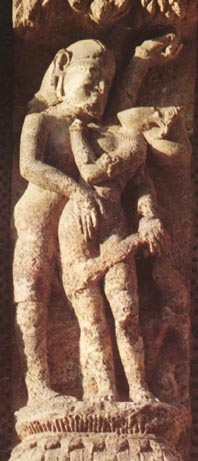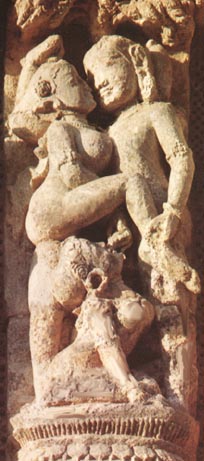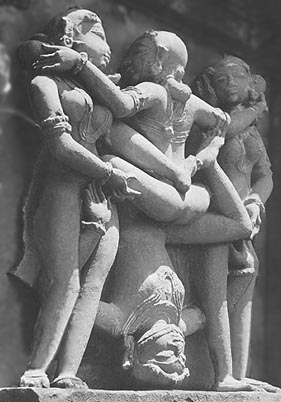 |
Many of the Hindu temples founded in the North and West of India were destroyed in the numerous conflicts that followed the advent of Islam in the 7th Century. These Muslims could only see the statues, and carvings of the Gods and Goddesses as evil, and vandalised them in the name of Allah.
Consequently, the best works are found in the temples to the South, which have fared far better, and these have provided much of the material in this web site. No outside force since the Aryan invaders in 2000BC has been able to impact India in any lasting way. Even the effects of British colonialism which lasted 200 years are fading; a clear testament to the durability of this great religion. Left and right, from the temple at Konarak |
 |
|
Why then, are so many of these puritans, Indians? Could there be another interpretation of the Vedas? In the country of the Kama Sutra, where amorous ecstasy is assimilated to mystic experience, to the perception of the divine that is supreme enjoyment, the puritanism of modern India arising from Islamic and Anglo-Saxon prejudice, is all the more stupefying, although it largely only concerns the managerial classes with English education. Mahatma Gandhi, educated in England, sent squads of his disciples to smash the erotic representations on the temples. The great poet Rabindranath Tagore, managed to put a stop this. Homosexuality The Kama Sutra describes all aspects of love without pretence and with next to no judgement. An English translation at the turn of the century, turned the simply descriptive "lesbians" into "corrupt women", and "dildos" into "medicine". Fortunately, these moralistic inaccuracies have recently been corrected, and the ancient authors' descriptions are once again as they were intended to be. The love of sexuality and its variants was never formerly persecuted in India, a land with a unity of diversity. It was only starting with the new penal code of Nehru's government that certain sexual relations were made punishable. Interestingly, these politicians even claimed that homosexuality had not existed in India until it was introduced from the West. However, careful inspection of the temples reveals that it has been an intrinsic and accepted part of the culture for hundreds, if not thousands of years. Even today, sexual play between members of the same sex is commonplace; even among people who regard themselves as heterosexual. Nonetheless, much the social tide of the country moved against homosexuality, and consequently, one of the most developed cultures in the world has thus been relegated to the level of the most backward, in the sphere of personal liberty. However, the Indian intelligentsia and some Indian media are turning against this tide, and, according to Alain Danielou (author of the first unabridged modern translation of the Kama Sutra) the intelligent traveller can (outside of official circles) find amorous adventures that show that the people of India have forgotten nothing of the Kama Sutra's teachings. |
||
 The sexual aspects of Hinduism are explicit, erotic and exotic. There is no doubt that puritans will feel they must avert their eyes when faced with this art.
The sexual aspects of Hinduism are explicit, erotic and exotic. There is no doubt that puritans will feel they must avert their eyes when faced with this art.